In the Philippines, the majority of the population identifies as Roman Catholic, significantly influencing the country's education system. The public education system incorporates religious instruction into the curriculum, with the goal of promoting moral development through formal classes. For instance, Catholic schools teach Catholicism as a subject, and students attend masses and participate in religious activities.
However, this integration faces challenges, particularly when it comes to the significant Muslim minority. There is a growing demand for inclusive approaches that reflect the country's diverse beliefs and cultural heritage. For example, some schools have introduced Islamic studies and Arabic language classes to cater to Muslim students.
Contemporary issues also affect the relationship between religion and education in the Philippines. Declining church attendance and evolving youth values further complicate this landscape.
Understanding these dynamics is crucial to revealing deeper insights into the future of education and faith in society.
Historical Context of Religion
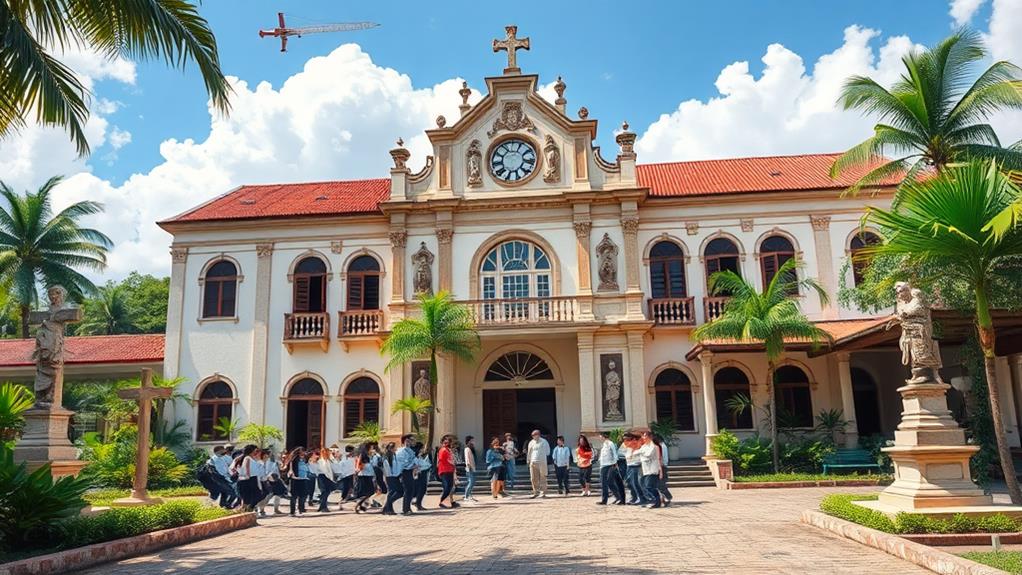
The Philippines' religious landscape has been shaped by its complex history.
Before Spanish colonization, indigenous Filipinos practiced animism, believing in a multitude of gods and goddesses, with Bathala as the supreme deity. This ancient belief system was deeply rooted in the daily lives of Filipinos.
The introduction of Islam in 1350 marked the beginning of a significant Muslim presence, particularly in Mindanao and Sulu. This paved the way for the coexistence of multiple religious beliefs in the Philippines.
When the Spanish arrived in 1565, they brought Catholicism, which became deeply ingrained in Filipino culture. Parish priests played a crucial role in both spiritual and community governance, influencing the social fabric of the country.
The American colonial period, which began in 1898, introduced Protestantism through educators who shaped the education system. This led to the growth of nationalized churches, such as the Aglipayan Church.
Today, the historical context of religion in the Philippines underscores its impact on education. Public schools, established during American rule, often include religious instruction, primarily led by Catholic educators.
This integration of religion and education reflects the complex interplay of cultural, historical, and social factors that continue to shape the Philippines.
The ongoing relevance of diverse religious beliefs in contemporary society is a testament to the country's rich cultural heritage.
Education System Overview
Religious Instruction in Philippine Public Schools
The Philippine education system integrates religious instruction in public elementary and high schools. Religious classes are conducted for 30 minutes, three times a week, with instructors often assigned by religious organizations like the Catholic Church. This integration was officially marked by the 1953 Administrative Order by President Quirino, reflecting the values of the Christian majority.
Religious Education Shapes Moral Framework and Cultural Identity
Religious education significantly shapes the moral framework and cultural identity of Filipino students, particularly through subjects like Christian Living. This is evident in the values and principles instilled in students, which are essential in molding their character and worldview.
Challenges in the Education Sector
However, recent trends indicate challenges within the education sector. Private school enrollment declined by 50% during the 2021-2022 school year, highlighting the need for improvement in the education system.
Inclusivity and Respect for Muslim Students
In response to the diverse religious landscape, the Department of Education supports the Values Education (ALIVE) Program. This program serves 173,641 Muslim students across 2,644 public elementary schools, promoting inclusivity and respect for the Muslim population within the broader educational framework.
This initiative showcases the ongoing interplay between religion and education in the Philippines.
Role of the Catholic Church
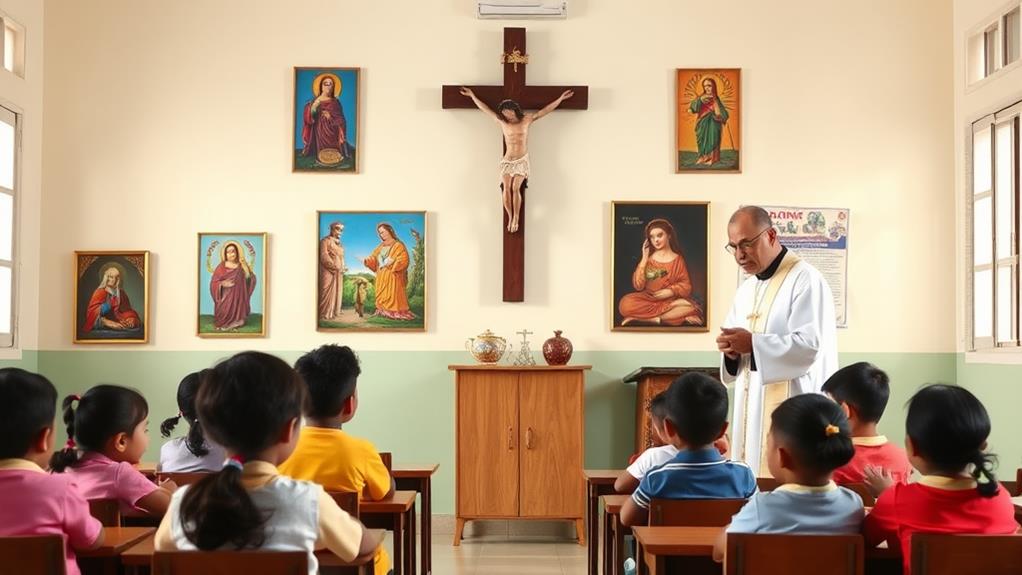
The Catholic Church's Influence on Education in the Philippines
The Catholic Church has played a significant role in shaping the educational landscape of the Philippines.
Historical Roots
The Church has been involved in education since the American colonial period.
In the early 20th century, the Church assigned instructors to teach religious classes in public schools, integrating moral values into the educational system.
Advocating for Religious Education
The Church successfully campaigned for in-school religious classes through President Quirino's 1953 Administrative Order, reflecting the Filipino people's desire for religious education.
Addressing Social Concerns
In the 1950s, concerns about juvenile delinquency and communism led parents to seek education that included Catechism instruction, further solidifying the Church's role in shaping moral values.
Political Influence
The Catholic Church's impact extends to politics, influencing presidential elections and advocating for candidates aligned with its interests.
Challenges in a Pluralistic Society
As the nation becomes increasingly pluralistic, the Church faces challenges.
Engaging in inter-faith dialogue and adapting to the selective adherence of younger generations to Church teachings will be crucial for the Catholic Church to maintain its relevance in religious education.
Religious Instruction Policies
Religious Instruction in Philippine Public Schools
In the Philippines, public elementary and high schools incorporate religious instruction, reflecting the strong influence of the Catholic Church on educational policies. This practice was established during the American colonial period and formalized in the 1950s.
Key Aspects of Religious Instruction Policies
| Aspect | Details |
|---|---|
| Duration | 30 minutes, three times a week |
| Instructors | Assigned by religious organizations |
| Parental Consent | Required for student participation |
| Historical Context | Initiated during the American colonial period |
| Legal Framework | Supports religious freedom in education |
The 1953 Administrative Order by President Quirino highlights the Catholic Church's significant role in shaping these educational policies. Many parents demand religious education, and some are reluctant to enroll their children in schools lacking such instruction. This reflects a broader societal concern for moral development amidst social issues, emphasizing the intertwining of educational policy and religious values in the Philippines.
Challenges in Religious Education
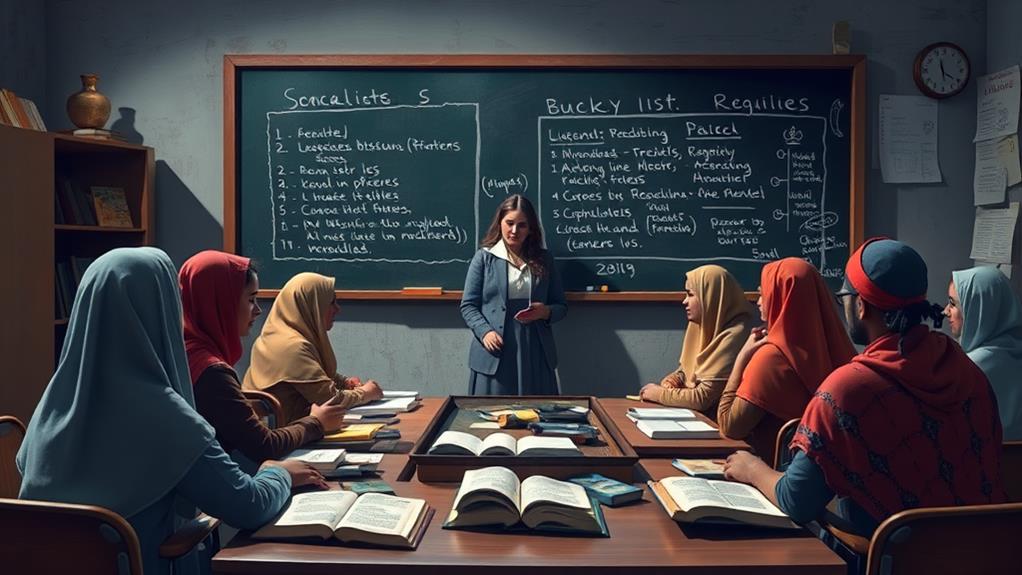
Cultural Diversity Challenges Religious Education
The Philippines' culturally diverse society creates challenges for religious education.
The country's diverse beliefs and values must be considered when teaching religion. For instance, in public schools, the Catholic curriculum may not resonate with Muslim students, who make up a significant minority.
Adapting to Generational Shifts
Traditional religious education must evolve to stay relevant to younger generations.
Young Filipinos are selective in their adherence to Church teachings, indicating a need for modern and engaging approaches to religious education.
Fostering Mutual Understanding in Mindanao
Historical and cultural tensions between Christians and Muslims in Mindanao complicate the teaching of moral values.
To promote understanding, the curriculum must address these tensions and foster mutual respect.
Funding Challenges for Islamic Education
Islamic institutions face difficulties in sustaining themselves within the broader education system in the Philippines.
Declining funding and attendance for madrassah education highlight the need for support.
To effectively promote moral values, religious education must address these challenges and respect the diverse beliefs of Filipino society.
A thoughtful and inclusive approach to education is essential.
Impact of COVID-19
The COVID-19 pandemic has significantly impacted religious education in the Philippines. The pandemic has accelerated existing challenges and introduced new dynamics, leading to a decline in church attendance from 34% in 2019 to 28% in 2021.
Traditional religious practices have adapted to online formats. To comply with health mandates, many religious institutions have shifted their practices online, resulting in a change in the way people engage with their faith.
Instruction in public schools has been disrupted. Students have been hesitant to return to physical classrooms, mirroring the reluctance seen in congregations. As a result, engagement levels have diminished, and many have prioritized convenience over the deeper values of religious education.
Clergy have focused on political issues rather than core Church doctrines. This shift has contributed to a dilution of religious significance, particularly among the youth, raising concerns about the long-term implications for both educational and religious institutions.
Trust and participation have waned, leaving questions about the future of religious instruction in a post-pandemic Philippines.
The interplay between education and religion requires thoughtful examination. As both sectors navigate recovery and renewal in a changed world, it's essential to examine the relationship between education and religion to ensure a strong foundation for future generations.
Societal Attitudes Towards Religion
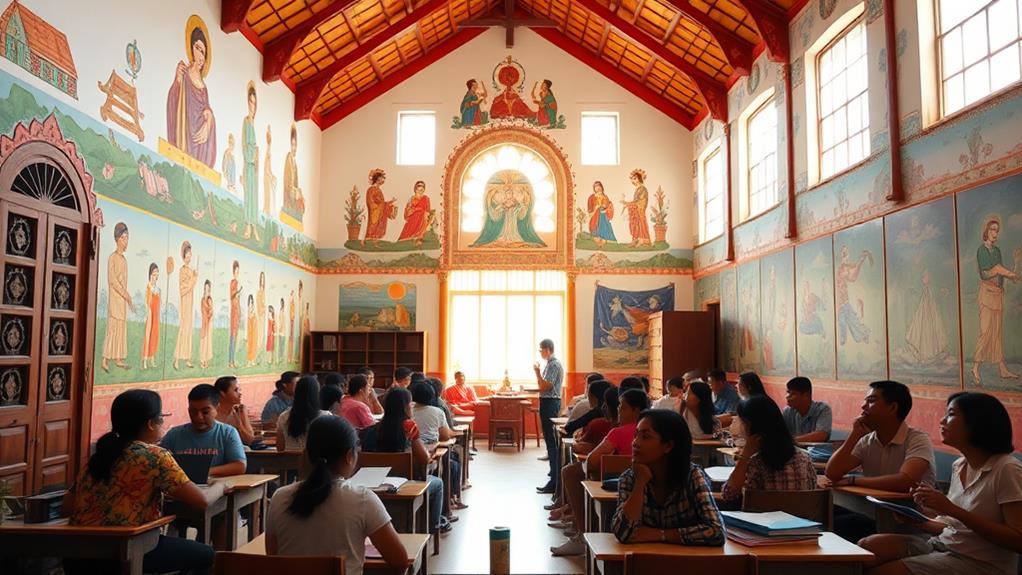
Societal attitudes towards religion in the Philippines are shaped by cultural, historical, and contemporary factors.
The Catholic Church significantly influences moral and ethical values, with 79.5% of the population identifying as Roman Catholic. However, recent trends indicate shifts in these attitudes, particularly among younger generations.
Public schools have seen a demand for religious education, especially Catholic teachings, since the 1950s. This reflects a societal response to social issues like juvenile delinquency.
Regular church attendance has declined, from 34% in 2019 to 28% in 2021. This suggests that traditional practices may be losing their grip.
Younger Filipinos adapt church teachings to align with contemporary values, indicating a selective adherence to religious norms. For example, they may choose to prioritize social justice over traditional dogma.
Discrimination against Muslim Filipinos highlights ongoing societal tensions, revealing the complexities of religious diversity in the country. This discrimination is a significant issue that needs to be addressed.
These factors illustrate how societal attitudes towards religion aren't static; they evolve, reflecting broader cultural shifts and the dynamic interplay between faith and identity in the Philippines.
Future of Religious Engagement
The Future of Religious Engagement in the Philippines
The Philippines is experiencing a decline in church attendance, with a drop from 34% to 28% between 2019 and 2021. This shift indicates that traditional religious practices may need to evolve to remain relevant.
In public schools, where there's still high demand for religious education, there is an opportunity to adapt curricula to contemporary realities. For instance, integrating inter-faith dialogue into religious education can foster national integration and enhance inclusivity. This approach enriches the quality of education and prepares students to engage respectfully with diverse beliefs.
The COVID-19 pandemic has accelerated the shift toward online engagement, which often lacks the depth of in-person experiences.
To revitalize religious engagement, communities must recommit to core values and actively involve youth in both educational and religious institutions. By doing so, the Philippines can cultivate a future where religious engagement is vibrant, inclusive, and responsive to the needs of an evolving society.
How Does the Education System in the Philippines Incorporate Religious and Spiritual Teaching?
The education system in the Philippines acknowledges the important relationship of religion and spirituality by incorporating religious and spiritual teachings into the curriculum. Students have the opportunity to learn about various faith traditions and moral values, helping them develop a deeper understanding of the role of religion in society.
Cultural Syncretism in Education
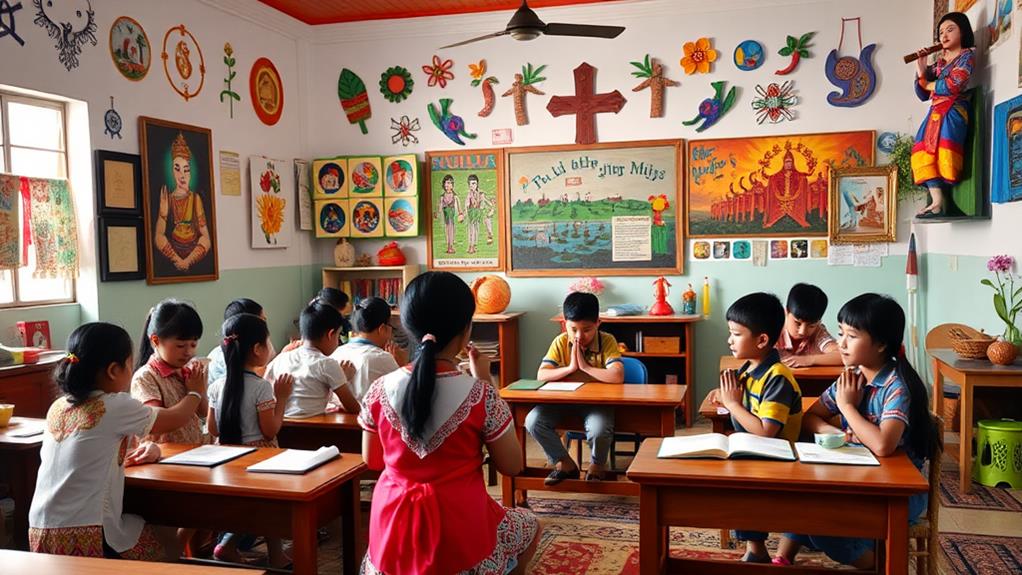
Cultural Syncretism in Education: Embracing Diversity
The Philippine Education Landscape
The Philippines is experiencing a shift in religious engagement, leading to the emergence of cultural syncretism in education.
Cultural syncretism is the blending of beliefs, which is evident in various educational settings, particularly in public schools.
Manifestations of Cultural Syncretism
In public schools, cultural syncretism is seen in:
- The integration of Catholic doctrines within Christian Living subjects, which reflects indigenous and foreign influences.
- Educational policies favoring faith-based content, often sidelining the diverse backgrounds of students.
- The inclusion of Islamic education initiatives, such as the ALIVE program, aimed at fostering multicultural perspectives.
- The decline in madrassah attendance and funding, illustrating how religious education adapts to modern societal challenges.
The Role of Religious Organizations
Religious organizations play a crucial role in promoting inter-faith dialogue.
The historical context of religious education, shaped by colonial influences, informs not only national identity but also the importance of inclusivity.
Creating Inclusive Learning Spaces
Community Involvement and Support
Community Involvement and Support
Community involvement plays a vital role in creating an inclusive atmosphere that respects religious diversity in the Philippines.
Initiatives like the ALIVE program, which supports over 173,000 Muslim students in public schools, demonstrate the impact of community participation on religious education. This program showcases how community involvement enriches religious education.
Local schools promote moral education through voluntary religious classes, allowing parents to engage actively in their children's spiritual development. This approach enables parents to take an active role in shaping their children's values and beliefs.
Organizations like the Asia Society Museum facilitate cultural education by hosting exhibitions that enhance understanding of various religious beliefs.
Community support in resource creation, donations, and active membership is essential for these initiatives to thrive.
Four key areas of community involvement stand out:
Public Schools: The ALIVE program supports Muslim students in public schools.
Religious Education: Voluntary classes allow parental engagement in religious education.
Cultural Education: Exhibitions promote understanding of religious diversity.
Moral Education: Community involvement emphasizes values education.
The U.S. embassy's investment in community learning facilities further highlights the commitment to fostering dialogue about religious freedom, ensuring that every voice is heard within the educational landscape.
Questions and Answers
How Does Religion Affect the Educational Context in the Philippines?
Religion plays a significant role in shaping the educational context in the Philippines.
In the Philippines, religion influences the curriculum by incorporating faith-based lessons and moral education.
For example, Catholic schools may include teachings on Catholic values and morals, while Islamic schools may focus on Islamic studies and Arabic language. This integration of religious values into lessons helps foster a sense of spirituality in schools.
However, with students from diverse religious backgrounds, interfaith dialogue becomes crucial to respect and understand differing beliefs. Educators must create inclusive environments that honor various faiths.
For instance, teachers can encourage open discussions and debates, promoting mutual respect and understanding among students from different religious backgrounds. By doing so, educators can enrich students' educational experiences and prepare them for a multicultural society.
Do Public Schools in the Philippines Teach Religion?
Yes, public schools in the Philippines teach religion through a religious education curriculum. This curriculum allows students to explore their faith while ensuring adherence to broader educational standards.
The religious education curriculum emphasizes student religious freedom, which means students are free to choose their own religion and beliefs.
The inclusion of moral values education in public schools reflects the complex dynamics of church-state relations in the Philippines.
This approach balances educational objectives with diverse religious beliefs, promoting inclusivity within the classroom. For example, students may learn about different religions, such as Catholicism, Islam, and Buddhism, to appreciate the diversity of religious beliefs in the country.
What Is the Religious Influence in the Philippines?
Religion plays a significant role in shaping the cultural identity and moral values of the Philippines. The country's cultural landscape is deeply influenced by its rich religious diversity, which combines indigenous beliefs, Christianity, and Islam.
This unique blend of faiths fosters dialogue and mutual respect among different religious groups.
Faith-based initiatives are common in the Philippines. Many communities engage in various initiatives that promote spiritual development, such as church-sponsored programs, Islamic missionary work, and indigenous rituals.
These initiatives bring people together and strengthen community bonds.
Religious influence affects daily life and societal norms in the Philippines. For example, the majority of Filipinos, who are Christians, observe Sunday as a day of rest and worship.
Muslims, on the other hand, observe Friday as their day of prayer. Indigenous communities continue to practice their traditional beliefs and customs, which are often intertwined with their daily lives.
These religious practices shape the country's social fabric and influence its cultural identity.
What Is the Relationship Between Religion and Education?
The relationship between religion and education is interconnected through faith-based initiatives. These initiatives focus on spiritual development and moral education, shaping students' characters and guiding them toward ethical behavior and community engagement. For instance, many religious schools integrate character formation into their curricula, teaching students values such as empathy, kindness, and respect for others.
Acknowledging religious diversity in educational settings enriches the learning experience. This is because it fosters an inclusive environment where students from different religious backgrounds can share their perspectives and learn from one another. For example, a classroom discussion on religious holidays can help students understand and appreciate the diversity of celebrations and traditions.
Integrating faith-based initiatives and religious diversity promotes a holistic approach to education. This approach supports both individual growth and societal cohesion, ultimately enhancing overall student well-being.